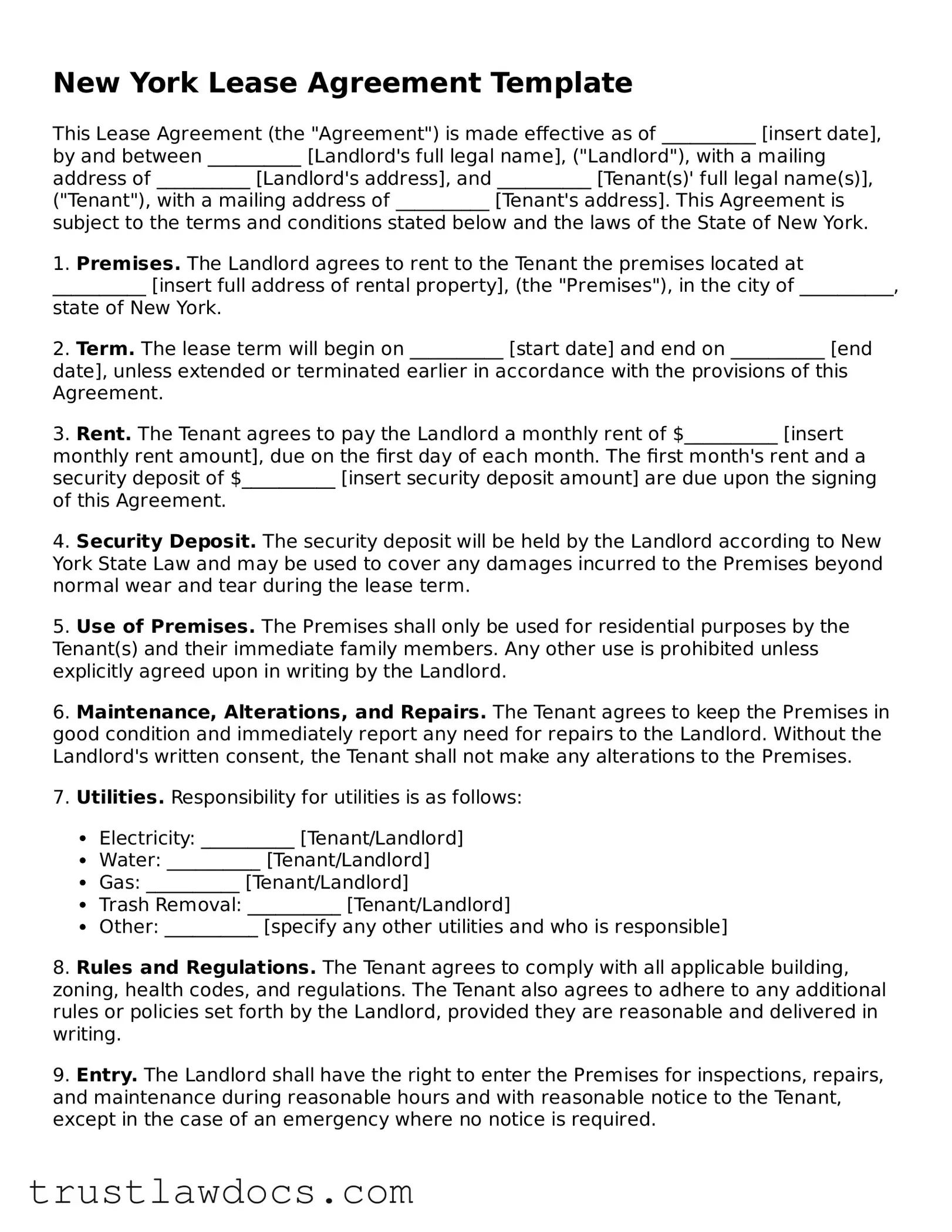New York Lease Agreement Template
This Lease Agreement (the "Agreement") is made effective as of __________ [insert date], by and between __________ [Landlord's full legal name], ("Landlord"), with a mailing address of __________ [Landlord's address], and __________ [Tenant(s)' full legal name(s)], ("Tenant"), with a mailing address of __________ [Tenant's address]. This Agreement is subject to the terms and conditions stated below and the laws of the State of New York.
1. Premises. The Landlord agrees to rent to the Tenant the premises located at __________ [insert full address of rental property], (the "Premises"), in the city of __________, state of New York.
2. Term. The lease term will begin on __________ [start date] and end on __________ [end date], unless extended or terminated earlier in accordance with the provisions of this Agreement.
3. Rent. The Tenant agrees to pay the Landlord a monthly rent of $__________ [insert monthly rent amount], due on the first day of each month. The first month's rent and a security deposit of $__________ [insert security deposit amount] are due upon the signing of this Agreement.
4. Security Deposit. The security deposit will be held by the Landlord according to New York State Law and may be used to cover any damages incurred to the Premises beyond normal wear and tear during the lease term.
5. Use of Premises. The Premises shall only be used for residential purposes by the Tenant(s) and their immediate family members. Any other use is prohibited unless explicitly agreed upon in writing by the Landlord.
6. Maintenance, Alterations, and Repairs. The Tenant agrees to keep the Premises in good condition and immediately report any need for repairs to the Landlord. Without the Landlord's written consent, the Tenant shall not make any alterations to the Premises.
7. Utilities. Responsibility for utilities is as follows:
- Electricity: __________ [Tenant/Landlord]
- Water: __________ [Tenant/Landlord]
- Gas: __________ [Tenant/Landlord]
- Trash Removal: __________ [Tenant/Landlord]
- Other: __________ [specify any other utilities and who is responsible]
8. Rules and Regulations. The Tenant agrees to comply with all applicable building, zoning, health codes, and regulations. The Tenant also agrees to adhere to any additional rules or policies set forth by the Landlord, provided they are reasonable and delivered in writing.
9. Entry. The Landlord shall have the right to enter the Premises for inspections, repairs, and maintenance during reasonable hours and with reasonable notice to the Tenant, except in the case of an emergency where no notice is required.
10. Termination and Renewal. Either party may choose not to renew this Agreement by providing written notice __________ [insert number of days] days before the end of the term. Upon termination, the Tenant agrees to return the Premises in the same condition as at the beginning of the lease, reasonable wear and tear excepted.
11. Governing Law. This Agreement shall be governed by and construed in accordance with the laws of the State of New York.
12. Signatures. This Agreement, entered into at __________ [location of signing], is signed on this __________ [date of signing] by the following parties:
Landlord: __________ [Landlord's signature]
Tenant: __________ [Tenant(s)' signature(s)]
